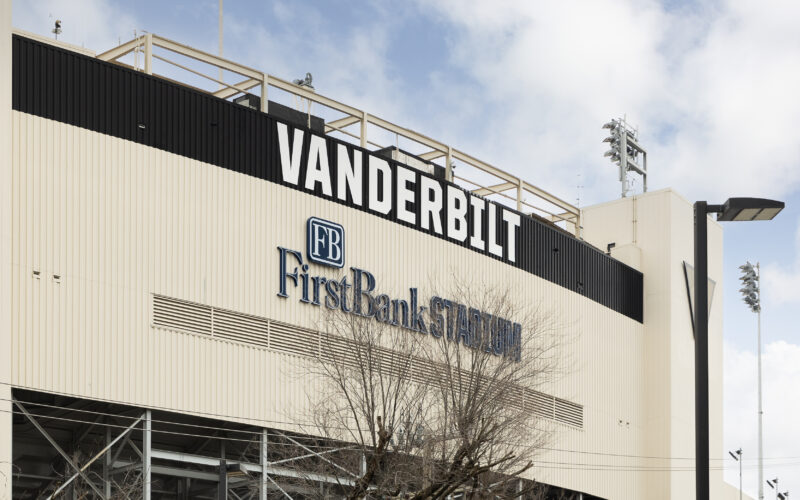Image via iStock
By Madison Keezer
It’s a Saturday morning in October. The birds are chirping, the sun is shining, and college students all over the country are dunking their heads in ice water and drinking alcohol for breakfast. College football is an American phenomenon. Even at Vanderbilt, home of the Commodores, the stadium is packed on Saturdays (even with our 2-10 record for the 2023 season). Whether you’re spending your Saturday afternoon in front of the TV, joining the hordes of fans taking over college towns, or are one of the lucky students cheering on your team from the student section, there’s no debating that college football is electric.
However, it’s not all fun and games – literally. The driving force behind college football is, unsurprisingly, money. But has this commercialization gone too far?
How do schools make money from football?
Yet, despite these large sums shelled out to coaches, top football universities still come out in the green.
A successful football team is more than just something to brag about for a university. A top Division I program can bring in huge sums of money for the school. The first stream of revenue is ticket sales. According to USA Today, top-earner Ohio State University made over $69 million in athletic event ticket sales in 2018. This is 33% of their total athletics revenue. The University of Texas was not so far behind in 2022, with $57 million in ticket sales. TV contracts are also a money-maker for colleges. Visiting teams are paid to play in “guaranteed” games, as described by USA today in Steve Berkowitz’s article titled “This year’s ‘guarantee games’ worth $150 million for college football programs.” Many of these games are contracted years in advance, often between teams of different conferences, and sometimes take place at neutral sites. USA Today reports that $150 million worth of payments for these “guaranteed games” were made throughout the 2017 season. At the same time, the expenses of universities relating to college football cannot be overlooked. One of the heftiest expenses is coaching staff. USA Today’s Tom Schad and Steve Berkowitz, in their article titled “Why college football is king in coaching pay − even at blue blood basketball schools,” report that “the public schools in the Power Five conferences will pay their head coaches an average of $6.2 million this year.” Yet, despite these large sums shelled out to coaches, top football universities still come out in the green.
Tailgates and games themselves provide a place to connect with friends. Even alumni are attracted to reconnect with their university. An investment into the football program could be an effective investment for the university itself.
Schools may also reap benefits from their football programs indirectly. Through a phenomenon known as the “Flutie Effect,” a popular football program could increase enrollment. Doug Chung explores this effect in his study titled “The Dynamic Advertising Effect of Collegiate Athletics,” published in Marketing Science, a peer-reviewed journal that focuses on the empirical and theoretical quantitative research in marketing. Chung details how, after Boston College quarterback Doug Flutie threw a 48-yard pass that was caught for a touchdown to beat Miami, BC saw enrollment applications increase 30%. In his study, he reported that underdog football schools, or colleges with a traditionally weak football program that have an unusually successful season, see applications increase by 17.7%. Colleges with better football programs may be more attractive to students because of the culture football fosters. Tailgates and games themselves provide a place to connect with friends. Even alumni are attracted to reconnect with their university. An investment into the football program could be an effective investment for the university itself.
Why do schools change conferences?
By waiting to leave the [Pac-12] conference until the deal ends in 2024, the schools avoid having to pay exit fees. The schools then enter conferences with stable and higher-paying media contracts.
Collegiate sports conferences were once defined by region, but now do not rely upon geographic ties. UCLA, USC, University of Oregon, and the University of Washington have decided to leave their own conferences to join the Big Ten conference, made up of mostly Midwest schools. By 2024, the conference will have eighteen schools. Fred Bown, in his article titled “College football is more and more about the money” for The Washington Post, writes that “In other words, the Big Ten could be called the Really Big Ten.” The driving factor behind these schools jumping ship is, once again, money. According to CNN, the schools’ former conference, Pac-12, approaches the end of its media rights deal with ESPN and FOX. By waiting to leave the conference until the deal ends in 2024, the schools avoid having to pay exit fees. The schools then enter conferences with stable and higher-paying media contracts. In fact, in an article titled “College Football Realignment 2024: How Every School Changing Conferences Is Doing,” by Kevin Borba for Sports Illustrated reports that so many colleges have defected from the Pac-12 conference that it verges on extinction, with only two schools remaining.
How do players get paid?
If college football is really a profit-driven business, it is only natural to classify players as employees. However, in an article titled “NIL in college football: Here’s what you need to know, and what’s next” for Sports Illustrated, James Parks notes that college football players legally cannot be paid. This rule is highly controversial, especially as college football brings in increasingly large sums of money. The two main work-arounds to the rule through which players can receive compensation is through scholarships and through NIL (name, image, and likeness). Barrett Sallee’s article “The Business of College Football: What a Scholarship Entails” for Bleacher Report breaks down the value of a typical Auburn University scholarship. Scholarships usually cover tuition, room and board, and textbooks/materials. Game day meals, special travel expenses, and other miscellaneous expenses are also covered by a typical full-ride football scholarship. A scholarship for an in-state student will be worth less because tuition is significantly cheaper. Taking this into account, Bleacher Report calculates that “based on cost of attendance estimates for 2012-2013, Auburn will be providing $2,648,096 worth of goods and services to members of its current active football roster.” Yet, when compared to the $44 million of football revenue brought in by the Auburn players during 2012 football season, it’s difficult to justify these scholarships as appropriate replacements for players’ salaries.
Businesses cannot offer a prospect a deal that is contingent on them playing for a specific school. This stops colleges from indirectly offering money to prospects. However, prospects may still be more likely to commit to a school with a larger public image in hopes of making more money.
The new NIL rules, or name, image, and likeness, help supplement the lack of compensation for football players by their schools. As per the article by Parks, before 2021, collegiate student-athletes could not sell their likeness or profit off themselves while receiving scholarships. In June 2021, the Supreme Court repealed this law in NCAA v Alston by ruling that the NCAA could not limit any education-related payments to students. As a result, businesses could pay players to use them in advertisements, products, or public appearances. There are, however, stipulations. Businesses cannot offer a prospect a deal that is contingent on them playing for a specific school. This stops colleges from indirectly offering money to prospects. However, prospects may still be more likely to commit to a school with a larger public image in hopes of making more money.
Despite indirect compensation from scholarships and NIL, college football players are still vastly under-compensated relative to the revenue produced by football programs. In fact, according to Josh Schafer’s article “NIL: Here’s how much athletes earned in the first year of new NCAA rules” for Yahoo Finance, the average NCAA Division I athlete had received $3,711 through NIL in 2021. However, it may not be an issue for long. In the concurring opinion for NCAA vs Alston, Justice Brett Kavanaugh writes that “it is highly questionable whether the NCAA and its member colleges can justify not paying student athletes a fair share of the revenues on the circular theory that the defining characteristic of college sports is that the colleges do not pay student athletes.”
Has commercialization gone too far?
Perhaps the decision to start paying players, however much they do deserve it, completes the slow evolution of college football into a professional sport.
Many of the decisions in college football are driven by money. But for those who view college football not just as a money-generating scheme, but as a sport grounded in tradition, loyalty, and passion, modern football may have strayed from its origins. Perhaps the decision to start paying players, however much they do deserve it, completes the slow evolution of college football into a professional sport. In Sean Illing’s article “College football is a money making sham” for Vox, he interviewed Mike McIntire of The New York Times about his book “Champions Way: Football, Florida, and the Lost Soul of College Sports,” which aims to expose the corrupt aspect of college sports. McIntire remarks, “I used to teach at a university with a major Division I football program … [a] lot of these players are ushered through a system without much regard for their academic development. The goal is to keep them academically eligible so they can produce on the field.” McIntire goes on to argue that college football players are often set up for failure if their post-graduate professional football careers don’t work out. With the increasing commercialization of college football, college communities must begin to reckon with the sacrifices of student-athletes.




